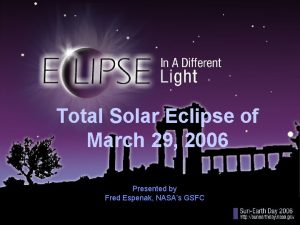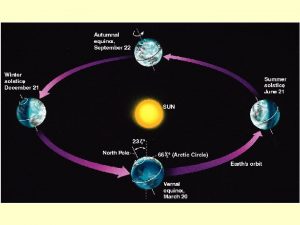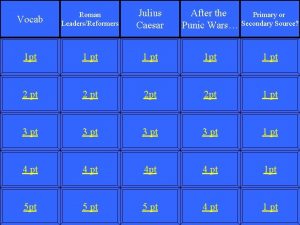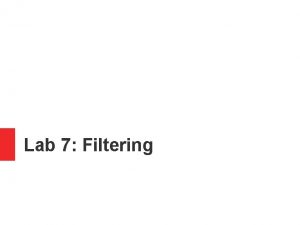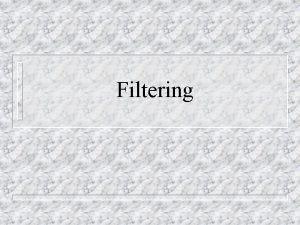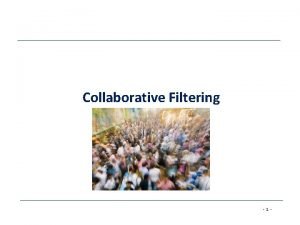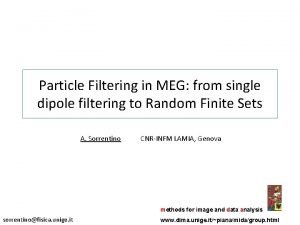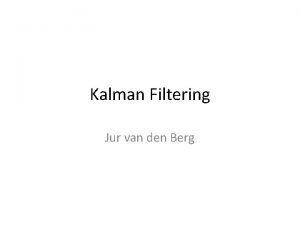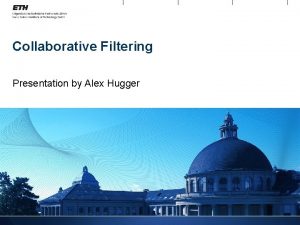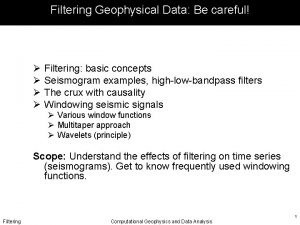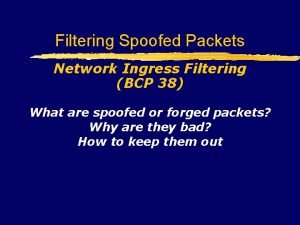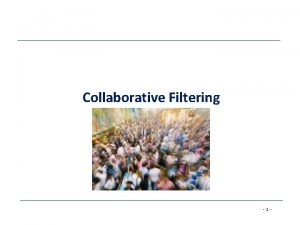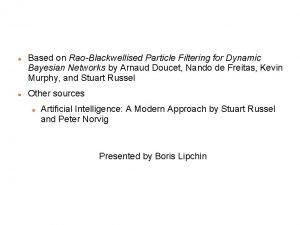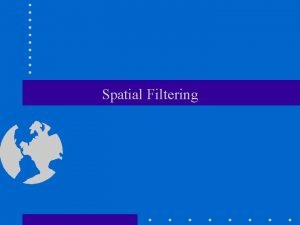09 March 2021 Review of Filtering Filtering in




















![Derivative of 2 D Gaussian filter * [1 -1] = Hays Derivative of 2 D Gaussian filter * [1 -1] = Hays](https://slidetodoc.com/presentation_image_h/3041353e939a8c9d56491f899e72373f/image-21.jpg)




































- Slides: 57

09 March 2021

Review of Filtering • Filtering in frequency domain – Can be faster than filtering in spatial domain (for large filters) – Can help understand effect of filter – Algorithm: 1. Convert image and filter to Fourier domain (e. g. , numpy. fft 2()) 2. Element-wise multiply their decompositions 3. Convert result to spatial domain with inverse Fourier transform (e. g. , numpy. fft. ifft 2()) You will play with code in Proj 2 questions Hays

Review of Filtering • Linear filters for basic processing – Edge filter (high-pass) – Gaussian filter (low-pass) [-1 1] Gaussian FFT of Gradient Filter FFT of Gaussian Hays

More Useful Filters 1 st Derivative of Gaussian (Laplacian of Gaussian) Earl F. Glynn

Things to Remember Sometimes it helps to think of images and filtering in the frequency domain – Fourier analysis Can be faster to filter using FFT for large images – N log. N vs. N 2 for convolution/correlation Images are mostly smooth – Basis for compression Remember to low-pass before sampling • Otherwise you create aliasing Hays

EDGE / BOUNDARY DETECTION Szeliski 4. 2 Many slides from James Hays, Lana Lazebnik, Steve Seitz, David Forsyth, David Lowe, Fei-Fei Li, and Derek Hoiem

Edge detection Goal: Identify visual changes (discontinuities) in an image. Intuitively, semantic information is encoded in edges. Think-pair-share: What are some ‘causes’ of visual edges? Source: D. Lowe

Origin of Edges surface normal discontinuity depth discontinuity surface color discontinuity illumination discontinuity • Edges are caused by a variety of factors Source: Steve Seitz

Why do we care about edges? Extract information – Recognize objects Help recover geometry and viewpoint Vanishing line Vanishing point Vertical vanishing point (at infinity) Vanishing point

Closeup of edges Source: D. Hoiem

Closeup of edges Source: D. Hoiem

Closeup of edges Source: D. Hoiem

Closeup of edges Source: D. Hoiem

Characterizing edges • An edge is a place of rapid change in the image intensity function (along horizontal scanline) first derivative edges correspond to extrema of derivative Hays

Intensity derivative Intensity profile Source: D. Hoiem x

Intensity derivative With a little Gaussian noise x Source: D. Hoiem

Effects of noise • Consider a single row or column of the image – Plotting intensity as a function of position gives a signal Where is the edge? Source: S. Seitz

Effects of noise • Difference filters respond strongly to noise – Image noise results in pixels that look very different from their neighbors – Generally, the larger the noise the stronger the response • What can we do about it? Source: D. Forsyth

Solution: smooth first f g f*g • To find edges, look for peaks in Source: S. Seitz

Derivative theorem of convolution • Convolution is differentiable: • This saves us one operation: f Source: S. Seitz
![Derivative of 2 D Gaussian filter 1 1 Hays Derivative of 2 D Gaussian filter * [1 -1] = Hays](https://slidetodoc.com/presentation_image_h/3041353e939a8c9d56491f899e72373f/image-21.jpg)
Derivative of 2 D Gaussian filter * [1 -1] = Hays

Tradeoff between smoothing and localization 1 pixel 3 pixels 7 pixels • Smoothed derivative removes noise, but blurs edge. Also finds edges at different “scales”. Source: D. Forsyth

Think-Pair-Share What is a good edge detector? Do we lose information when we look at edges? Are edges ‘complete’ as a representation of images?

Designing an edge detector • Criteria for a good edge detector: – Good detection: the optimal detector should find all real edges, ignoring noise or other artifacts – Good localization • the edges detected must be as close as possible to the true edges • the detector must return one point only for each true edge point • Cues of edge detection – Differences in color, intensity, or texture across the boundary – Continuity and closure – High-level knowledge Source: L. Fei-Fei

Designing an edge detector • “All real edges” • We can aim to differentiate later on which edges are ‘useful’ for our applications. • If we can’t find all things which could be called an edge, we don’t have that choice. • Is this possible?

Closeup of edges Source: D. Hoiem

Elder – Are Edges Incomplete? 1999 What information would we need to ‘invert’ the edge detection process?

Elder – Are Edges Incomplete? 1999 Edge ‘code’: - position, - gradient magnitude, - gradient direction, - blur size.

Where do humans see boundaries? image human segmentation gradient magnitude • Berkeley segmentation database: http: //www. eecs. berkeley. edu/Research/Projects/CS/vision/grouping/segbench/ p. B slides: Hays

Results Score = confidence of edge. For humans, this is averaged across multiple participants. Pb (0. 88) Human (0. 95)

Results Score = confidence of edge. For humans, this is averaged across multiple participants. Pb Human (0. 96) Pb (0. 88) Global Pb

Score = confidence of edge. For humans, this is averaged across multiple participants. Pb (0. 63) Human (0. 95)

Score = confidence of edge. For humans, this is averaged across multiple participants. Pb (0. 35) Human (0. 90) For more: http: //www. eecs. berkeley. edu/Research/Projects /CS/vision/bsds/bench/html/108082 -color. html

45 years of boundary detection Source: Arbelaez, Maire, Fowlkes, and Malik. TPAMI 2011

State of edge detection Local edge detection works well – ‘False positives’ from illumination and texture edges (depends on our application). Some methods to take into account longer contours Modern methods that actually “learn” from data. Poor use of object and high-level information. Hays

Summary: Edges primer • Edge detection to identify visual change in image • Derivative of Gaussian and linear combination of convolutions • What is an edge? What is a good edge? f

Canny edge detector • Probably the most widely used edge detector in computer vision. • Theoretical model: step-edges corrupted by additive Gaussian noise. • Canny showed that first derivative of Gaussian closely approximates the operator that optimizes the product of signal-to-noise ratio and localization. J. Canny, A Computational Approach To Edge Detection, IEEE Trans. Pattern Analysis and Machine Intelligence, 8: 679 -714, 1986. 22, 000 citations! L. Fei-Fei

Demonstrator Image rgb 2 gray(‘img. png’)

Canny edge detector 1. Filter image with x, y derivatives of Gaussian Source: D. Lowe, L. Fei-Fei

Derivative of Gaussian filter x-direction y-direction

Compute Gradients X Derivative of Gaussian Y Derivative of Gaussian (x 2 + 0. 5 for visualization)

Canny edge detector 1. Filter image with x, y derivatives of Gaussian 2. Find magnitude and orientation of gradient Source: D. Lowe, L. Fei-Fei

Compute Gradient Magnitude sqrt( XDeriv. Of. Gaussian. ^2 + YDeriv. Of. Gaussian. ^2 ) = gradient magnitude (x 4 for visualization)

Compute Gradient Orientation • Threshold magnitude at minimum level • Get orientation via theta = atan 2(y. Deriv, x. Deriv)

Canny edge detector 1. Filter image with x, y derivatives of Gaussian 2. Find magnitude and orientation of gradient 3. Non-maximum suppression: – Thin multi-pixel wide “ridges” to single pixel width Source: D. Lowe, L. Fei-Fei

Non-maximum suppression for each orientation At pixel q: We have a maximum if the value is larger than those at both p and at r. Interpolate along gradient direction to get these values. Source: D. Forsyth

Before Non-max Suppression Gradient magnitude (x 4 for visualization)

After non-max suppression Gradient magnitude (x 4 for visualization)

Canny edge detector 1. Filter image with x, y derivatives of Gaussian 2. Find magnitude and orientation of gradient 3. Non-maximum suppression: – Thin multi-pixel wide “ridges” to single pixel width 4. ‘Hysteresis’ Thresholding Source: D. Lowe, L. Fei-Fei

‘Hysteresis’ thresholding • • Two thresholds – high and low Grad. mag. > high threshold? = strong edge Grad. mag. < low threshold? noise In between = weak edge • ‘Follow’ edges starting from strong edge pixels • Continue them into weak edges • Connected components (Szeliski 3. 3. 4) Source: S. Seitz

Final Canny Edges

Effect of (Gaussian kernel spread/size) Original The choice of depends on desired behavior • large detects large scale edges • small detects fine features Source: S. Seitz

Canny edge detector 1. Filter image with x, y derivatives of Gaussian 2. Find magnitude and orientation of gradient 3. Non-maximum suppression: – Thin multi-pixel wide “ridges” to single pixel width 4. ‘Hysteresis’ Thresholding: – Define two thresholds: low and high – Use the high threshold to start edge curves and the low threshold to continue them – ‘Follow’ edges starting from strong edge pixels • Connected components (Szeliski 3. 3. 4) • Python: e. g. , skimage. feature. canny() Source: D. Lowe, L. Fei-Fei

Sidebar: Bilinear Interpolation http: //en. wikipedia. org/wiki/Bilinear_interpolation

Sidebar: Interpolation options e. g. , skimage. transform. rescale( I, 2, order=x ) x == 0 -> ‘nearest neighbor’ – Copy value from nearest known – Very fast but creates blocky edges x == 1 -> ‘bilinear’ (default) – Weighted average from four nearest known pixels – Fast and reasonable results x == 3 => ‘bicubic’ – Fit cubic spline to pixel intensities – Non-linear interpolation over larger area (4 x 4) – Slower, visually appealing, may create negative pixel values in cubic function fitting Examples from http: //en. wikipedia. org/wiki/Bicubic_interpolation

Canny edge demo!!!

From Luke Murray (Fall 2017 TA) • https: //cse 442 -17 f. github. io/Sobel-Laplacianand-Canny-Edge-Detection-Algorithms/ • Written in https: //idyll-lang. org/ [Additional information]
 March march dabrowski
March march dabrowski Ingress filtering vs egress filtering
Ingress filtering vs egress filtering Current events quiz 2021
Current events quiz 2021 March 5 2021
March 5 2021 Chapter review motion part a vocabulary review answer key
Chapter review motion part a vocabulary review answer key Ap gov final review
Ap gov final review Narrative review vs systematic review
Narrative review vs systematic review Systematic review definition
Systematic review definition Narrative review vs systematic review
Narrative review vs systematic review Grihalakshmi magazine march 2019
Grihalakshmi magazine march 2019 When was van gogh born
When was van gogh born Source russia march
Source russia march March 1917 revolution
March 1917 revolution Abraham lincoln
Abraham lincoln Sherman's march significance
Sherman's march significance Path of sherman's march to the sea
Path of sherman's march to the sea Path of sherman's march to the sea
Path of sherman's march to the sea 9 line medevac card
9 line medevac card Aleida march de la torre
Aleida march de la torre March april may season
March april may season Why rizal left london for paris in march 1899?
Why rizal left london for paris in march 1899? January february maruary
January february maruary Sherman's march to the sea
Sherman's march to the sea March 30 1981
March 30 1981 March hemoglobinürisi
March hemoglobinürisi 20 mile march
20 mile march Glasgow 5 march 1971
Glasgow 5 march 1971 Glasgow 5th march 1971
Glasgow 5th march 1971 Sansculottes
Sansculottes 535 before 14 march
535 before 14 march Civil war map sherman's march to the sea
Civil war map sherman's march to the sea Drill and ceremony commands
Drill and ceremony commands Death march edward yourdon
Death march edward yourdon Heath of the brandenburg march
Heath of the brandenburg march How to solve trade discount series
How to solve trade discount series Analyze the responses of franklin dbq
Analyze the responses of franklin dbq Chapter 15 section 4 aggressors invade nations
Chapter 15 section 4 aggressors invade nations Azure bug bounty
Azure bug bounty What is my zodiac sign chinese
What is my zodiac sign chinese March madness banner
March madness banner Astronomy picture of the day march 29 2006
Astronomy picture of the day march 29 2006 March algorthym
March algorthym Seasons spring summer fall winter
Seasons spring summer fall winter Ce abrasive blasting respirator
Ce abrasive blasting respirator March 1, 1803
March 1, 1803 March joint powers authority
March joint powers authority 21 march equinox
21 march equinox 3 major battles of the texas revolution
3 major battles of the texas revolution The march king questions and answers
The march king questions and answers Happy wednesday march
Happy wednesday march March 7, 2012
March 7, 2012 Cscape envisionrv
Cscape envisionrv Opie childhood sociology
Opie childhood sociology Ides of march punic wars
Ides of march punic wars Peep under the iron curtain
Peep under the iron curtain Colguen les gents ab alegria festes
Colguen les gents ab alegria festes March verb
March verb March 2013
March 2013








































